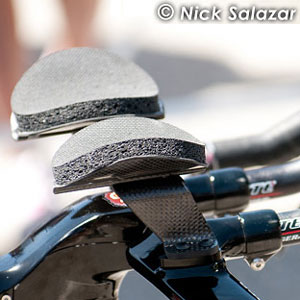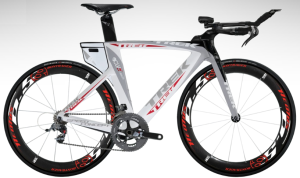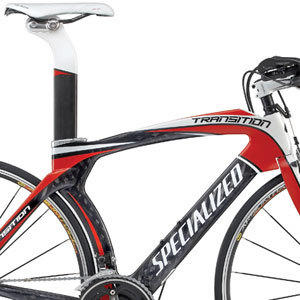
Ask anyone in the upper echelons at Trek, they’ll tell you that no project, whether in road, MTB, or any cycling category, sat above the Speed Concept. This was Trek’s clear priority for 2010, and as of this writing a visit to Trek’s online home yields a full-page pic of the Speed Concept. Isn’t it amazing that a tri bike was the top project of a company with an annual revenue (estimated several years ago by the New York Times and Inc. Magazine) north of $600 million?
Note the description of the Speed Concept as a tri bike. Not a TT bike built for a pro tour team, retasked for triathlon. No, this is a tri bike built for Chris Lieto, Julie Dibens, and you, and which is retasked for use by Lance and Levi.
But don’t worry too much for the boys who ride for The Shack. In point of fact, the distance between tri and TT is closing fast, and, all that distance has been traveled by the pro bke racers. It was tri geometry they should have been riding all along, we now know.
And that’s what the Speed Concept is. Trek is not the first pro tour team sponsor to built its pro tour TT bike as a tri bike first and a TT bike second. Cervelo proved it could be done, and, in subseqent years it’s become clear that this is not only one possible way to accommodate both tri and TT needs, it’s the preferable way. Further, it’s preferable not only to triathletes, but to the road riders who ride these tri bikes. Finally, Trek has capitulated to Cervelo’s narrative: there is little to no space between TT and and tri, and, the triathletes were geometrically right all along.
One thing about Trek: It is a proud company, but not an arrogant one. Whether in monocoque frames, full suspension mountain bikes, or tri bikes, it may take a false start or two; it may take two years, or three, to get it right; but, it will get it right. That is to say, it’ll get the product right, even if it needs to implicitly admit, through its industrial design, that another brand’s prior themes were worth borrowing in order to achieve success.

Geometrically, the Speed Concept plays it right down the middle. This bike started with stack and reach as design inputs, that is, the top tube lengths, front/center, and other metrics were largely resultant from frame length and height imperatives that Trek mandated. The attached graphic, borrowed from Trek’s Speed Concept White Paper, in turn borrows from our recent style of demonstrating geometric trends among bike brands (and we have no problem with that). That graphic demonstrates the care Trek has taken to thread the geometric needle throughout its size run, and, an attachment to even increments between sizes. This is new for Trek, at least in the grading of its tri bike sizes.
But the frame is not the end of the story. Riders fit aboard bikes, and these are constructs of frame + the stem/aerobar complex. Geometrically, how does the Speed Concept fare as a complete bike? Trek’s done a good job of creating a superbike with true adjustability. This, if your definition of superbike is a modern aero frame that integrates the aerobar, fork and frame at the expense of a traditional stem and headset spacers. Trek did what Giant, with its Trinity Advanced, failed to do: It waited to release its bike until stems in various lengths were ready to be sold alongside the bike.
Trek offers six stem configs, although “stem” doesn’t accurately describe what might be better considered protruberances of the frame.
These are the stem offerings at least for the 9 Series (the higher end OCLV) as follows:
Low/Near: 10mm rise, 50mm reach
Low/Far: 10mm rise, 100mm reach
Mid/Near: 45mm rise, 60mm reach
Mid/Far: 45mm, 100mm reach
Tall/Near: 75mm rise, 80mm reach
Tall/Far: 75mm rise, 110mm reach

Makers of these new superbikes seem to have an easier time giving their bikes height adjustability than offering a lot of length options. The Giant Trinity Advanced gives you no stem length options other than what comes on the bike. At least the Speed Concept gives you two (per height option). If you like low profile aerobars, like I do, then you'll probably want to choose between the low/near and low/far stem options. This also because the Bontrager bars are rather high profile in the way the armrests mount above the pursuit bar. Will the 100mm work for me? Maybe, I don't know yet.
But that's not the end of the adjustability. The Bontrager aerobars mount the pads on the extensions, so, by moving the extensions in and out, and based on the pad placement, you get extra fore/aft adjustment options.
Here's the thing, though. If you resort to adjusting the cockpit through pad and extension movement, the pursuit bars aren't "following" the armests as they are adjusted fore and aft. I like my pursuit position tight, that is, the pursuit contact points back toward the bike, not well out in front of the bike. The one downside to the Speed Concept's adjustability schema is that pursuit position. Will I like it? I don't know, I've had a bit of a time getting my hands on Bontrager's aerobars for testing, so, as of this writing I just don't know.
Keep this in mind: If you find that the stem just isn't fitting you—that you need something, say, shorter than a 100mm, but not as short as a 50mm—in all likelihood you're just on a bike one size too big. If you need that 80mm stem instead of the 100mm, just get the next size down Speed Concept. The difference in length (reach) between each size is 2cm. So, go to the smaller bike size, with a higher-profile stem.
Likewise, if you find you need a 120mm stem rather than the 100mm stem available, then go to the next size up, and that'll work with the 100mm stem (just, that bike's going to be taller, too, so you'll need to move to a lower-profile stem in that 100mm length).
My only beef with these stem configs is the lack of a third option in the low-profile version. I'd like something right in between the 50mm and 100mm lengths. Time will tell if this is an omission that needs to be rectified.
The bike is built around a 78° seat angle. Hallelujah! Who'd've thought Trek would be making, and championing, a 78° seat angle tri bike as its TT bike for The Shack? Yet, here we are.
Finally, the bike comes with seat posts of different offsets, with reversible heads, much as does the Specialized Transition, so that any seat angle is achievable.
I'm very happy about a particular development, and that is the proper ergonimics associated with two companies' aerobar extensions: specifically Felt's and Trek's. If you look at the Felt F-bend, and the bend on the Bontrager bar coming on the Speed Concept, each company has taken a leap forward, and each has done something fairly similar to the other. When you consider that neither has developed a reputation as a dedicated tri bar company per se, I take my hat off to them both.

The handlebar also tilts. And, the pads can be raised above the pursuit bar incrementally, allowing the rider to choose the height the bars sit above the pursuit bar. And, if you really want to get funky, pictured is the custom mount for Levi Leipheimer, though I'm not really a fan of the position.
I haven't ridden a Speed Concept, haven't gone through the process of seeing whether and how this bike would fit me (as I did with Cannondale's Slice recently). Those who've read what I've written about bikes that are built to exceed the aerodynamic norm is that I'm all for them, but, not a the expense of giving up the basic functions a bike performs. Only a closer sniff would tell me whether the Speed Concept is as easy to set up as would be a bike with a traditional stem configuration.
But I can say that of all the bikes I've seen with disappearing stems, this is the most ambitious attempt at making sure adjustability is not lost, both through the unique and well-conceived set of stem configs, and the rationally-calculated 5 sizes, that increase almost exactly by 20mm of length and 25mm of height respectively, size to size.
The rest of the "below the waist" metrics of the Speed Concept also seem to make sense. The trail of each size is right at 60mm (near or at my idea of the ideal), and the front/centers range up to 650mm for the tallest size.
The BB drop on every size except the smallest is 80mm. This is a lot. This is a bike you'd want to be careful with if you like to pedal around corners. Otherwise, I think there's a real question whether the claimed aerodynamics of this bike has to do with its proximity to the ground. This I'll let others decide.
When I look at this bike, I see for myself a bike that is a geometric match for me in the 60cm size, in its length. But, that bike is too tall for me. It's probably a better height fit in size-58cm. Can this bike be made to fit me, and, if so, in which size? Perhaps I'll ask the folks from Trek to match my fit coordinates in both 58cm and 60cm sizes, take a couple of pics of these bikes, and send them my way. If we can get that done, I'll post them on Slowtwitch, and we'll see what Trek configs for my fit coordinates would look like. This might give readers an idea whether they like the look of larger or smaller frame sizes matched to their fit coordinates, and what such configs would look like once built.


